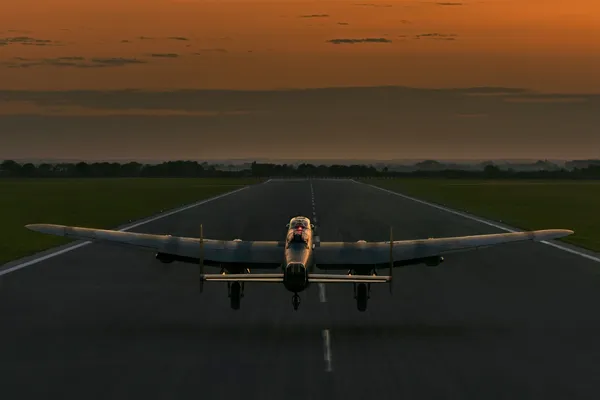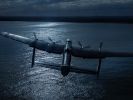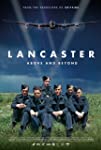Eye For Film >> Movies >> Lancaster (2022) Film Review
Lancaster
Reviewed by: Andrew Robertson

"Were they there?" is a question asked early in this film, and for many the answer is not just 'no' but 'no longer.' Lancaster takes its name from its subject, a bomber named for a city and by extension infamous in connection with another. Using archive footage colourised with the permission of the Imperial War Museum, interviews with the nonagenarian survivors of Bomber Command, and threaded through by the narration of Charles Dance, the film serves perhaps more as a tribute than a briefing on the plane and, more importantly, its crews.
The interviews are the most compelling part, most of them with a scale model of the eponymous aircraft somewhere in shot. I've got one over my shoulder as I type this, another couple tucked away in a box. On a shelf in a different direction I've got Sven Lindquist's A History Of Bombing. As such I'm almost certainly not the intended audience for Lancaster. To be clear, it is not that there's anything wrong with the film. In aiming for a high level view not just of the plane but its crews and its use, Lancaster spreads itself too thinly, and for all that there are powerful moments, it isn't so much that it's inaccurate as that it's ineffective.

There's a flying example in the Battle of Britain Memorial Flight, OA464. Based at RAF Coningsby, we see it several times with Eurofighter Typhoons behind it. A crew of seven, against a crew of one. Almost three times the wingspan, but barely half again as long. 53 years and change between first flights puts over 1000mph between their top speeds but also highlights how significant it is that the 'Lanc' could carry 10 tonnes of ordnance to the 9 tonnes on a fully laden Typhoon.
The Lancaster was a speculative derivation of the Manchester aircraft, itself a response to an Air Ministry specification. "a flying bomb bay", though the focus on its use of four of the iconic Merlin engine misses the way its structure worked to make that possible. It was also more readily modified, by late war the Lancaster had developed a near suburbia of bumps and podules to accommodate new equipment, new functions, new bombs. This a start contrast to the Barnes Wallis designed Wellington bomber, whose geodetic skeleton gave it tremendous strength but at cost. Wallis does appear in connection to Operation Chastise. The theme from The Dambusters is better known than We Are The Heavy Bombers but the latter adds something to the film.
That's in a film with no shortage of things added. There's a story of a visit to the AVRO factory which involves a lesson in manufacturing or rather 'making' that probably did put hairs on a chest. There are interviews with surviving aircrew from the Royal Air Force, the Royal Australian Air Force, the Royal Canadian Air Force and the Royal New Zealand Air Force, but also aircraft maintainers who come from Jamaica and a survivor who was a child in Dresden.
It isn't so much even-handedness as heavy-handedness to try to bring balance to work of Bomber Command. There's some attempt to exculpate or excuse 'Bomber' Harris, a discussion of strategic bombing with mention of the V-weapons from Peenemunde and the consequences of the Ruhr raids. That's a topic sufficiently large that its derivatives still elicit controversy, most recently perhaps in the repackaging of a variety of myths in Malcolm Gladwell's The Bomber Mafia It is discomfiting, and by rights it should be. Something made more so by an animated map where one cannot but notice Kyiv and Kursk.
There's a discussion of the creation of the Bomber Command Memorial, unveiled during the Diamond Jubilee year in The Green Park. It marks not just the 55,573 aircrew lost but also, explicitly, civilians of all nations killed during raids. There's a fascinating story behind that memorial, but also in the fact that despite their contribution to the war effort Bomber Command wasn't so remembered until decades later. There are glimpses of fascinating things throughout. I'd seen footage of the bouncing bomb tests, but not the destruction of a dam in Wales. Nor had I seen the original briefing models, and certainly not as closely as the camera can get. The interviews are affecting, these were young men, children even.
One talks about wanting to get into the war before it finished. A year to train as a pilot, nine months for a navigator, but just eight weeks for a gunner. So gunner it was. 55,000 aircraft parts crafted and fitted and jointed and sub-contracted and procedurally and incrementally improved flown by crews that assembled themselves in a hangar as if a speed-dating event, with all the foresight of clubbing together to catch a taxi after a cancelled train.
David Fairhead and Ant Palmer worked together on 2018's Spitfire, which had a cinematic release for the RAF's Centenary. The amalgamation of the Royal Flying Corps and the Royal Naval Air Service is another story entirely. Composer Chris Roe also returns from that project, but in truth the sights and sounds matter less than some of the descriptions.
The film does mention the Pathfinder groups, and it is perhaps in that role that Lancaster most succeeds. As a film, indeed, as much as an airframe. Flying ahead to illuminate, it was those behind that did the work. With sequences shot in the Lancaster's cramped interior and flashing lights in some seeming recreations, there is a glimpse with cinema sound giving us the slowly synchronising roar of those four engines of just a bit of what it was like. Aerial sequences appear to have been re-graded to swap day for night, but the sound of a quartet of V12s is majestic. Named not for the wizard but the bird, it is a treat to see it in flight and given the age of the airframe likely easier at the pictures than in person.
While we've got survivors, not just flesh and blood but riveted steel, there isn't mention made that the Lancaster's derivatives continued in service until 1991. The Shackleton, born of the Lincoln, itself born of the Lancaster was of the Manchester was used in an Airborne Early Warning Role well into the jet and space ages. That alone speaks to efficacy, to determination, though any discussion of lasting impacts is better done with maps than calendars.
"I fought my war from five miles up," and distance robs us of detail. It's the smell, the looks in faces, the memories of station dances. It's also in the things not said. There's mention of the 'Tall Boy' and the 'Grand Slam' but not by their other name of Earthquake Bombs. There are interesting stories here, but in trying to span them all it doesn't quite succeed. For some that lack won't be an issue, but for me it missed the mark.
Reviewed on: 24 May 2022

















